Photo

A Tunicate Medley
The Komodo National Park site in Indonesia was inscribed on the World Heritage List in 1991. The site hosts "Komodo dragons" (Varanus komodoensis), a unique species that exists nowhere else in the world and is of great interest to scientists studying evolution. The rugged hillsides of dry savannah and pockets of thorny green vegetation contrast starkly with the brilliant white sandy beaches and blue coral-rich waters offshore. Pictured here is some of the diversity of marine life in the park: three species of tunicates ("sea squirts") - Polycarpa aurata is purple and orange, Atriolum robustum is green, and the blue is from the genus Rhopalaea.
Photo Credit: Nick Hobgood
48 notes
·
View notes
Photo

A sneak peek before Wednesday’s 4th of July festivities. This polychaete reminds us of fireworks.
129 notes
·
View notes
Photo
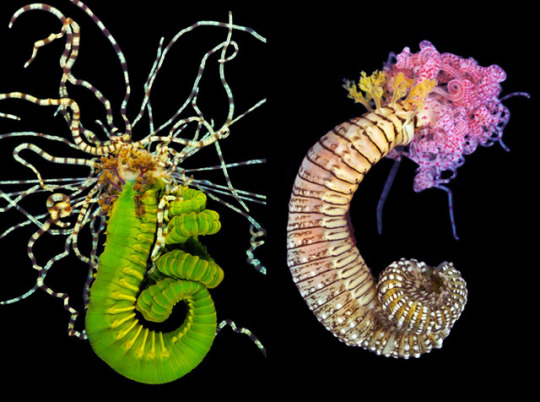
Spaghetti worms are named for the long, thin tentacles they use to feed and explore the seafloor around the opening of their tube.
278 notes
·
View notes
Photo
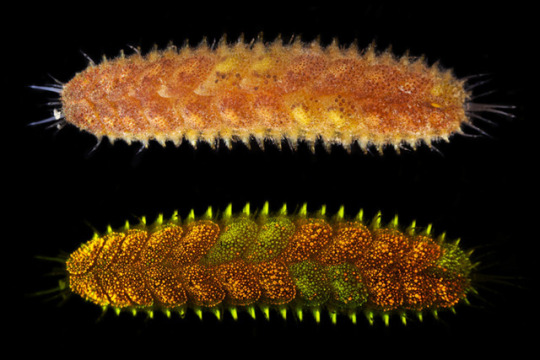
Your next polychaete on the hour.
This scale worm's bumpy scales and bristles glow brilliantly under fluorescent light
34 notes
·
View notes
Photo

Beautiful Worms? A photo series for Polychaete Day
This brilliant scaleworm spends its life with a sea star partner, which wears it like a piece of jewelry.
©Alexander Semenov
412 notes
·
View notes
Photo

Beautiful Worms? A photo series for Polychaete Day
This one looks like a rainbow.
©Alexander Semenov
32 notes
·
View notes
Photo

Sea Stars! (Class Asteroidea). #SciArt from Nature Neighbors, embracing birds, plants, animals, minerals, in natural colors by color photography, Vol. 5 (c1914) by Nathaniel Moore Banta. View more in #BHLib with thanks to the University Library of the University of Illinois, Urbana-Champaign for digitizing: http://ow.ly/dLRc309nIPY
_________________________________________________
#Seastars #Starfish #HistSciArt #HistoricalSciArt #BiodiversityHeritageLibrary #BHLib #Biodiversity #NaturalHistory #Science #Art #ArtAndScience #Illustration #ScienceArt #Artists #ArtHistory
51 notes
·
View notes
Photo

A levitating dolphin? Not quite!
When small cetaceans like this common dolphin make low leaps near the surface of the water while they travel, they are said to be porpoising. There are several theories about why dolphins leap like this, but some researchers believe it enables them to save energy.
(Photo: Peter Flood, taken near Stellwagen Bank National Marine Sanctuary)
[Image description: A head-on view of a common dolphin leaping forward out of the water.]
185 notes
·
View notes
Photo

If I said these creatures were our distant cousins, would you believe me? Well, they are!
About 3,000 tunicate species are found in salt water habitats throughout the world. Although tunicates are invertebrates (animals without backbones) found in the subphylum Tunicata (sometimes called Urochordata), they are part of the Phylum Chordata, which also includes animals with backbones, like us.
https://ocean.si.edu/tunicates-not-so-spineless-invertebrates
Photo Credit: Ian Davidson, Smithsonian
27 notes
·
View notes
Video
Some mesmerizing jellies for your hump day.
The National Museum of Natural History is more than just a museum. Heres a peek behind the scenes in the aquaroom, a jellyfish research lab. Today we visited and got to check out these beautiful cassiopea, or upside down jellyfish.
51 notes
·
View notes
Photo
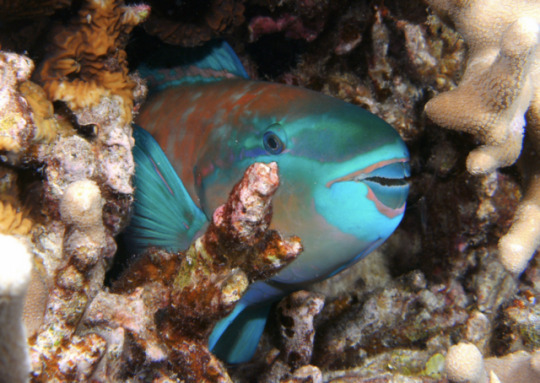
What goes in must come out in some form, and with parrotfish, what comes out is sand.
As the name might suggest, these tropical fish, with their big beaks and bright colors, look like their land-based counterparts. Parrotfish live in coral reefs and spend their days chomping down on coral. Hard coral is no match for the large beak of the parrotfish, which researchers have recently found is formed by some of the strongest teeth in the world.
https://ocean.si.edu/ocean-life/fish/tough-teeth-and-parrotfish-poop
29 notes
·
View notes
Photo

For residents of the Marshall Islands, a system of over a thousand islands found on 29 small atolls in the middle of the Pacific Ocean, sea level rise is already an existential threat. To help prepare for the future scientists from the U.S. Geological Survey (USGS) and other collaborating institutions are using drones and satellites to create 3D maps of the island.
https://ocean.si.edu/mapping-out-whats-next-marshall-islands
Photo Courtesty Monica Palaseanu-Lovejoy
5 notes
·
View notes
Photo

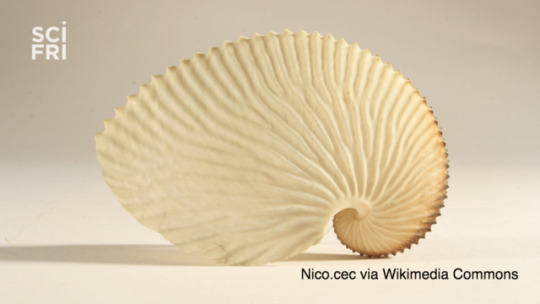

The argonaut octopus, of the family Argonautidae, belongs to a group of pale pink-spotted octopuses. Unlike the heroes that sailed the Argo in the Greek myth, these octopuses are known for traversing the open ocean by way of a delicate, curved, creamy white vessel—an external casing, often referred to as a “shell,” that gave them their common nickname, the “paper nautilus.”
These creatures baffled naturalists and philosophers for two millennia, even fooling Aristotle, who believed that they used their large pair of webbed dorsal arms as “a sail” to catch the briny breeze and floated across the ocean’s surface like paper boats. These myths carried weight for centuries, even among naturalists in the 19th century.
It wasn’t until the early 1830s when self-taught French naturalist, Jeanne Villepreux-Power began researching the Argonauta argo, or the greater argonaut, that we learned the true origins of their “shells.” Along the way, Villepreux-Power tried new methods for studying sea creatures that gave insights not just into the paper nautilus, but also helped us to better understand other creatures of the sea today. Meet the “mother of aquaria.”
1K notes
·
View notes
Photo
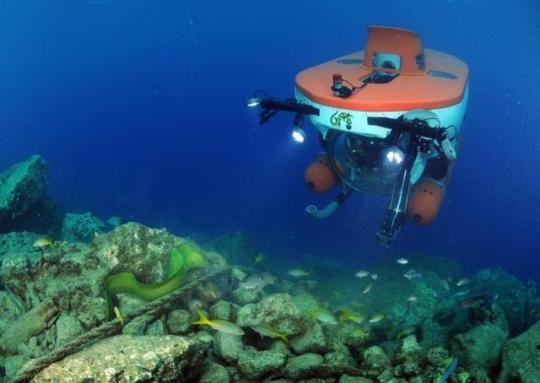
New Ocean Zone Discovered!
The newly recognized rariphotic zone ranges from 130 meters to at least 309 meters (427-1,014 feet). It is too deep for corals with photosynthetic algae to grow, and it is also too deep for even the specialized SCUBA equipment used to explore mesophotic reefs. Submersibles and remotely operated vehicles can explore the region, but they are expensive and normally used to scope out even deeper depths of the ocean. As a result, most reef researchers seldom make it to the rariphotic zone.
https://ocean.si.edu/new-ocean-zone-described-help-submersible
632 notes
·
View notes
Video
Yes, that is a beating heart! Scientist Rachael Heuer examines fish heart cells in an effort to learn how oil from an oil spill impacts the heart's functioning—and keeping the heart happy and pumping outside of the fish is just one step in figuring this out.
Turns out even a little bit of oil hinders heart functioning. Need more info? Read the full scoop at https://ocean.si.edu/fish-heart-out-water
Video courtesy of Rachel Heuer
32 notes
·
View notes
Photo

Walrus (Odobenus rosmarus). #SciArt by Louis Agassiz Fuertes for Edward William Nelson, The Larger North American Mammals (1916). View more in #BHLib via #Cornell University Library: http://ow.ly/4HDU30kthhC
_________________________________________________
#Walrus #mammals #zoology #HistSciArt #HistoricalSciArt #BiodiversityHeritageLibrary #BHLib #Biodiversity #NaturalHistory #Science #Art #ArtAndScience #Illustration #ScienceArt #Artists #ArtHistory
42 notes
·
View notes
Text

Smile—you’re halfway through the week! Commonly found swimming in ice-free northern waters, the harbor seal (Phoca vitulina) is one of the smaller seals. This species typically lives in saltwater bays and estuaries but also inhabits freshwater lakes and rivers. A harbor seal can be solitary, but sometimes joins groups along the shoreline. Unlike many other seals and sea lions, harbor seals can swim at birth. Yet pups stay dependent on their mothers for milk for up to six weeks—among the longest weaning period for all seals. Have you ever seen the bobbing heads of these seals in the water?
Photo: Andreas Trepte
319 notes
·
View notes